Accounting for Normal and Contingent Liabilities: A Financial Report
VerifiedAdded on 2020/04/01
|8
|2116
|44
Report
AI Summary
This report delves into the intricacies of accounting for both normal and contingent liabilities, emphasizing their recognition, measurement, and disclosure within financial statements. It examines the differences between normal and contingent liabilities, highlighting the criteria for recognition based on standards like IAS 37 and AASB 137. The report analyzes the importance of measurability and the impact of liabilities on the financial position and cash flow statements. It further explores the disclosure requirements for contingent liabilities, including opening and closing balances, movements, and uncertainties, using Rio Tinto Ltd's financial statements as a case study to illustrate practical application. The report concludes by stressing the importance of proper liability accounting for depicting the going concern concept of a firm.
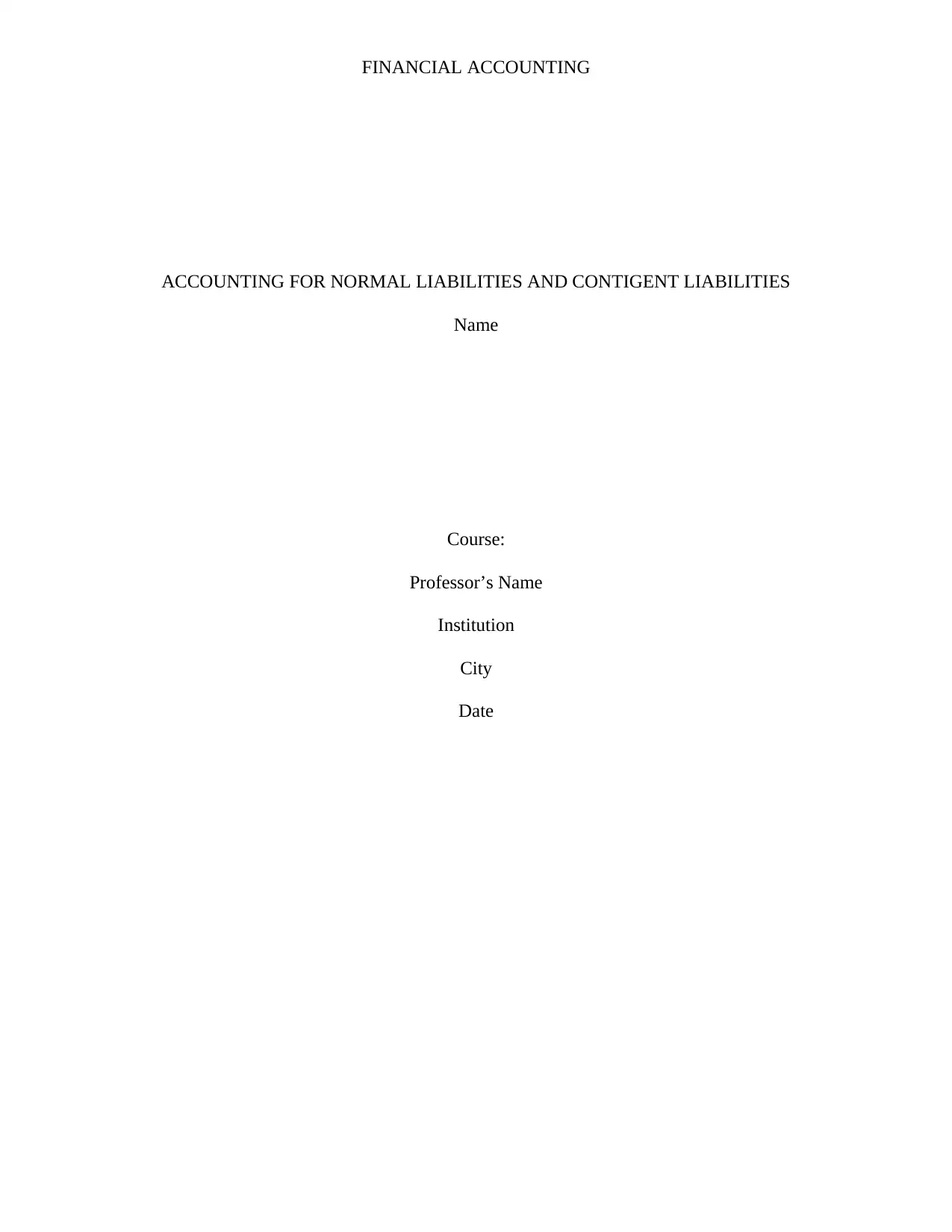
FINANCIAL ACCOUNTING
ACCOUNTING FOR NORMAL LIABILITIES AND CONTIGENT LIABILITIES
Name
Course:
Professor’s Name
Institution
City
Date
ACCOUNTING FOR NORMAL LIABILITIES AND CONTIGENT LIABILITIES
Name
Course:
Professor’s Name
Institution
City
Date
Paraphrase This Document
Need a fresh take? Get an instant paraphrase of this document with our AI Paraphraser
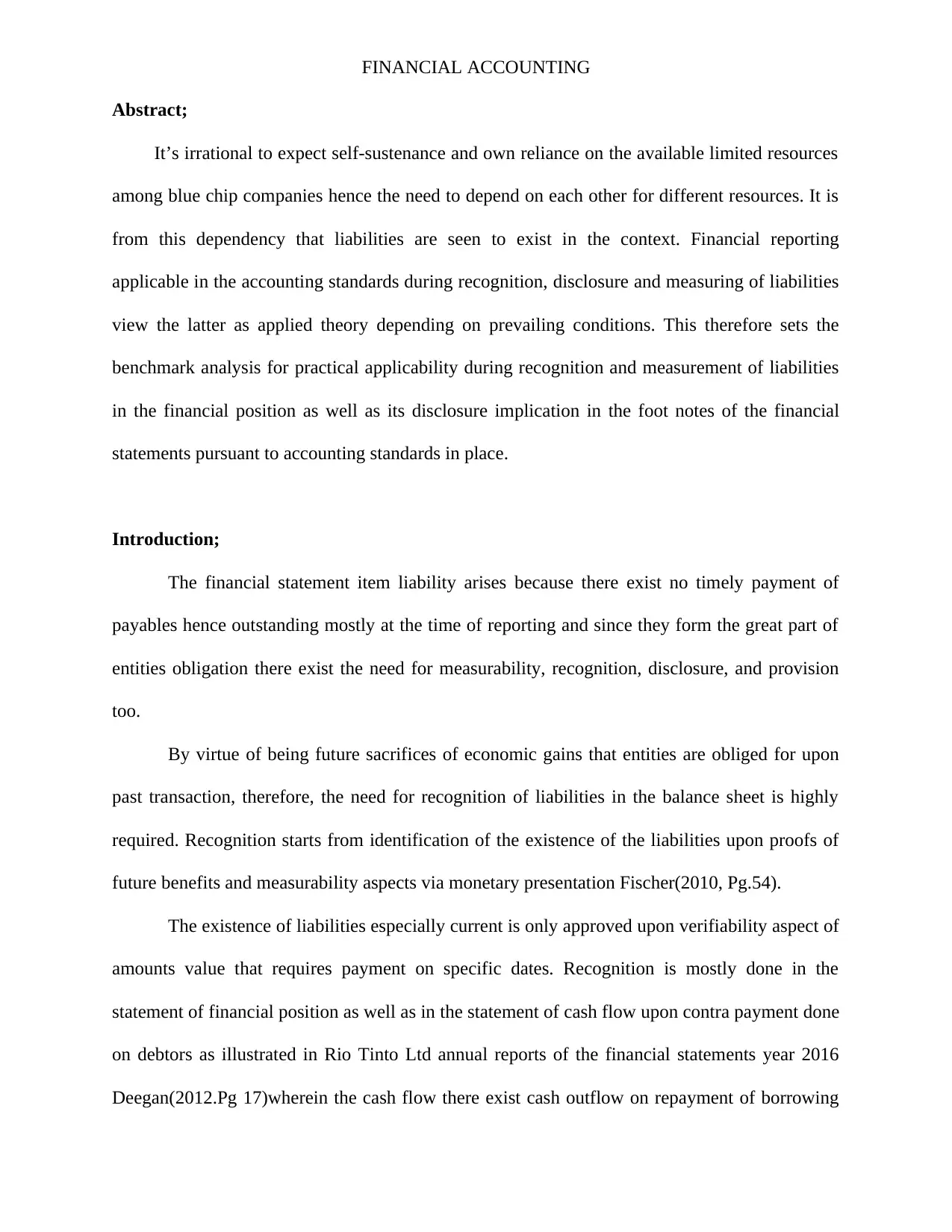
FINANCIAL ACCOUNTING
Abstract;
It’s irrational to expect self-sustenance and own reliance on the available limited resources
among blue chip companies hence the need to depend on each other for different resources. It is
from this dependency that liabilities are seen to exist in the context. Financial reporting
applicable in the accounting standards during recognition, disclosure and measuring of liabilities
view the latter as applied theory depending on prevailing conditions. This therefore sets the
benchmark analysis for practical applicability during recognition and measurement of liabilities
in the financial position as well as its disclosure implication in the foot notes of the financial
statements pursuant to accounting standards in place.
Introduction;
The financial statement item liability arises because there exist no timely payment of
payables hence outstanding mostly at the time of reporting and since they form the great part of
entities obligation there exist the need for measurability, recognition, disclosure, and provision
too.
By virtue of being future sacrifices of economic gains that entities are obliged for upon
past transaction, therefore, the need for recognition of liabilities in the balance sheet is highly
required. Recognition starts from identification of the existence of the liabilities upon proofs of
future benefits and measurability aspects via monetary presentation Fischer(2010, Pg.54).
The existence of liabilities especially current is only approved upon verifiability aspect of
amounts value that requires payment on specific dates. Recognition is mostly done in the
statement of financial position as well as in the statement of cash flow upon contra payment done
on debtors as illustrated in Rio Tinto Ltd annual reports of the financial statements year 2016
Deegan(2012.Pg 17)wherein the cash flow there exist cash outflow on repayment of borrowing
Abstract;
It’s irrational to expect self-sustenance and own reliance on the available limited resources
among blue chip companies hence the need to depend on each other for different resources. It is
from this dependency that liabilities are seen to exist in the context. Financial reporting
applicable in the accounting standards during recognition, disclosure and measuring of liabilities
view the latter as applied theory depending on prevailing conditions. This therefore sets the
benchmark analysis for practical applicability during recognition and measurement of liabilities
in the financial position as well as its disclosure implication in the foot notes of the financial
statements pursuant to accounting standards in place.
Introduction;
The financial statement item liability arises because there exist no timely payment of
payables hence outstanding mostly at the time of reporting and since they form the great part of
entities obligation there exist the need for measurability, recognition, disclosure, and provision
too.
By virtue of being future sacrifices of economic gains that entities are obliged for upon
past transaction, therefore, the need for recognition of liabilities in the balance sheet is highly
required. Recognition starts from identification of the existence of the liabilities upon proofs of
future benefits and measurability aspects via monetary presentation Fischer(2010, Pg.54).
The existence of liabilities especially current is only approved upon verifiability aspect of
amounts value that requires payment on specific dates. Recognition is mostly done in the
statement of financial position as well as in the statement of cash flow upon contra payment done
on debtors as illustrated in Rio Tinto Ltd annual reports of the financial statements year 2016
Deegan(2012.Pg 17)wherein the cash flow there exist cash outflow on repayment of borrowing
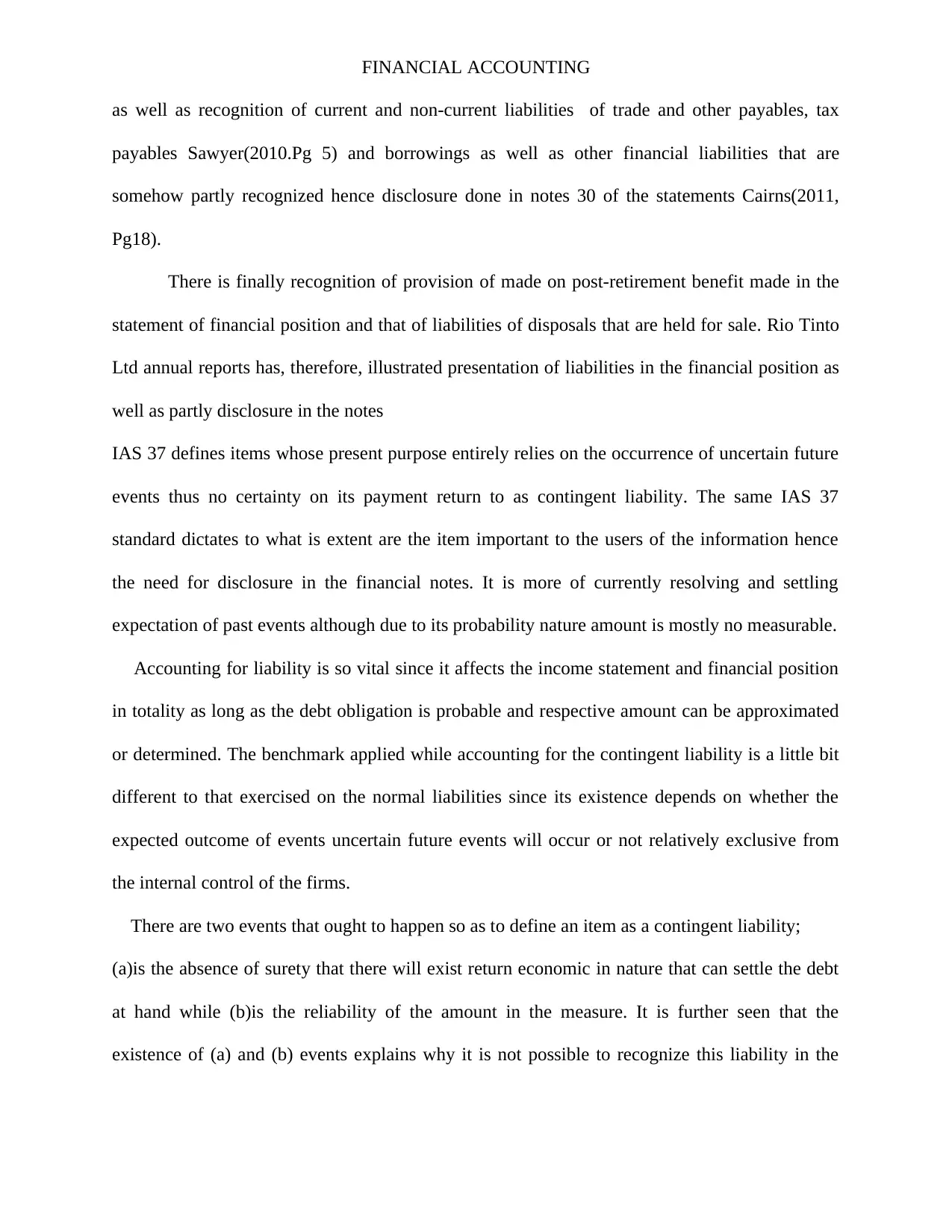
FINANCIAL ACCOUNTING
as well as recognition of current and non-current liabilities of trade and other payables, tax
payables Sawyer(2010.Pg 5) and borrowings as well as other financial liabilities that are
somehow partly recognized hence disclosure done in notes 30 of the statements Cairns(2011,
Pg18).
There is finally recognition of provision of made on post-retirement benefit made in the
statement of financial position and that of liabilities of disposals that are held for sale. Rio Tinto
Ltd annual reports has, therefore, illustrated presentation of liabilities in the financial position as
well as partly disclosure in the notes
IAS 37 defines items whose present purpose entirely relies on the occurrence of uncertain future
events thus no certainty on its payment return to as contingent liability. The same IAS 37
standard dictates to what is extent are the item important to the users of the information hence
the need for disclosure in the financial notes. It is more of currently resolving and settling
expectation of past events although due to its probability nature amount is mostly no measurable.
Accounting for liability is so vital since it affects the income statement and financial position
in totality as long as the debt obligation is probable and respective amount can be approximated
or determined. The benchmark applied while accounting for the contingent liability is a little bit
different to that exercised on the normal liabilities since its existence depends on whether the
expected outcome of events uncertain future events will occur or not relatively exclusive from
the internal control of the firms.
There are two events that ought to happen so as to define an item as a contingent liability;
(a)is the absence of surety that there will exist return economic in nature that can settle the debt
at hand while (b)is the reliability of the amount in the measure. It is further seen that the
existence of (a) and (b) events explains why it is not possible to recognize this liability in the
as well as recognition of current and non-current liabilities of trade and other payables, tax
payables Sawyer(2010.Pg 5) and borrowings as well as other financial liabilities that are
somehow partly recognized hence disclosure done in notes 30 of the statements Cairns(2011,
Pg18).
There is finally recognition of provision of made on post-retirement benefit made in the
statement of financial position and that of liabilities of disposals that are held for sale. Rio Tinto
Ltd annual reports has, therefore, illustrated presentation of liabilities in the financial position as
well as partly disclosure in the notes
IAS 37 defines items whose present purpose entirely relies on the occurrence of uncertain future
events thus no certainty on its payment return to as contingent liability. The same IAS 37
standard dictates to what is extent are the item important to the users of the information hence
the need for disclosure in the financial notes. It is more of currently resolving and settling
expectation of past events although due to its probability nature amount is mostly no measurable.
Accounting for liability is so vital since it affects the income statement and financial position
in totality as long as the debt obligation is probable and respective amount can be approximated
or determined. The benchmark applied while accounting for the contingent liability is a little bit
different to that exercised on the normal liabilities since its existence depends on whether the
expected outcome of events uncertain future events will occur or not relatively exclusive from
the internal control of the firms.
There are two events that ought to happen so as to define an item as a contingent liability;
(a)is the absence of surety that there will exist return economic in nature that can settle the debt
at hand while (b)is the reliability of the amount in the measure. It is further seen that the
existence of (a) and (b) events explains why it is not possible to recognize this liability in the
⊘ This is a preview!⊘
Do you want full access?
Subscribe today to unlock all pages.

Trusted by 1+ million students worldwide
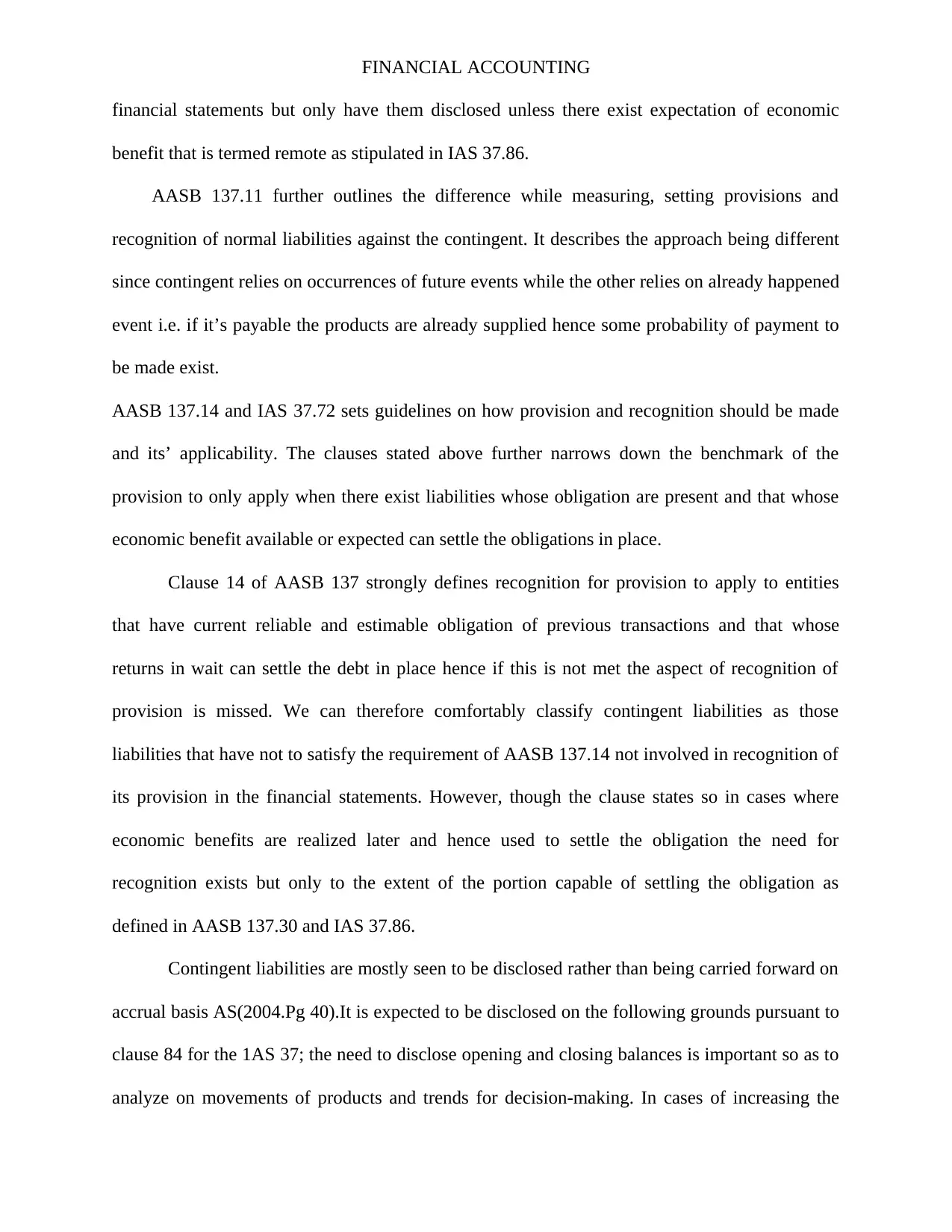
FINANCIAL ACCOUNTING
financial statements but only have them disclosed unless there exist expectation of economic
benefit that is termed remote as stipulated in IAS 37.86.
AASB 137.11 further outlines the difference while measuring, setting provisions and
recognition of normal liabilities against the contingent. It describes the approach being different
since contingent relies on occurrences of future events while the other relies on already happened
event i.e. if it’s payable the products are already supplied hence some probability of payment to
be made exist.
AASB 137.14 and IAS 37.72 sets guidelines on how provision and recognition should be made
and its’ applicability. The clauses stated above further narrows down the benchmark of the
provision to only apply when there exist liabilities whose obligation are present and that whose
economic benefit available or expected can settle the obligations in place.
Clause 14 of AASB 137 strongly defines recognition for provision to apply to entities
that have current reliable and estimable obligation of previous transactions and that whose
returns in wait can settle the debt in place hence if this is not met the aspect of recognition of
provision is missed. We can therefore comfortably classify contingent liabilities as those
liabilities that have not to satisfy the requirement of AASB 137.14 not involved in recognition of
its provision in the financial statements. However, though the clause states so in cases where
economic benefits are realized later and hence used to settle the obligation the need for
recognition exists but only to the extent of the portion capable of settling the obligation as
defined in AASB 137.30 and IAS 37.86.
Contingent liabilities are mostly seen to be disclosed rather than being carried forward on
accrual basis AS(2004.Pg 40).It is expected to be disclosed on the following grounds pursuant to
clause 84 for the 1AS 37; the need to disclose opening and closing balances is important so as to
analyze on movements of products and trends for decision-making. In cases of increasing the
financial statements but only have them disclosed unless there exist expectation of economic
benefit that is termed remote as stipulated in IAS 37.86.
AASB 137.11 further outlines the difference while measuring, setting provisions and
recognition of normal liabilities against the contingent. It describes the approach being different
since contingent relies on occurrences of future events while the other relies on already happened
event i.e. if it’s payable the products are already supplied hence some probability of payment to
be made exist.
AASB 137.14 and IAS 37.72 sets guidelines on how provision and recognition should be made
and its’ applicability. The clauses stated above further narrows down the benchmark of the
provision to only apply when there exist liabilities whose obligation are present and that whose
economic benefit available or expected can settle the obligations in place.
Clause 14 of AASB 137 strongly defines recognition for provision to apply to entities
that have current reliable and estimable obligation of previous transactions and that whose
returns in wait can settle the debt in place hence if this is not met the aspect of recognition of
provision is missed. We can therefore comfortably classify contingent liabilities as those
liabilities that have not to satisfy the requirement of AASB 137.14 not involved in recognition of
its provision in the financial statements. However, though the clause states so in cases where
economic benefits are realized later and hence used to settle the obligation the need for
recognition exists but only to the extent of the portion capable of settling the obligation as
defined in AASB 137.30 and IAS 37.86.
Contingent liabilities are mostly seen to be disclosed rather than being carried forward on
accrual basis AS(2004.Pg 40).It is expected to be disclosed on the following grounds pursuant to
clause 84 for the 1AS 37; the need to disclose opening and closing balances is important so as to
analyze on movements of products and trends for decision-making. In cases of increasing the
Paraphrase This Document
Need a fresh take? Get an instant paraphrase of this document with our AI Paraphraser
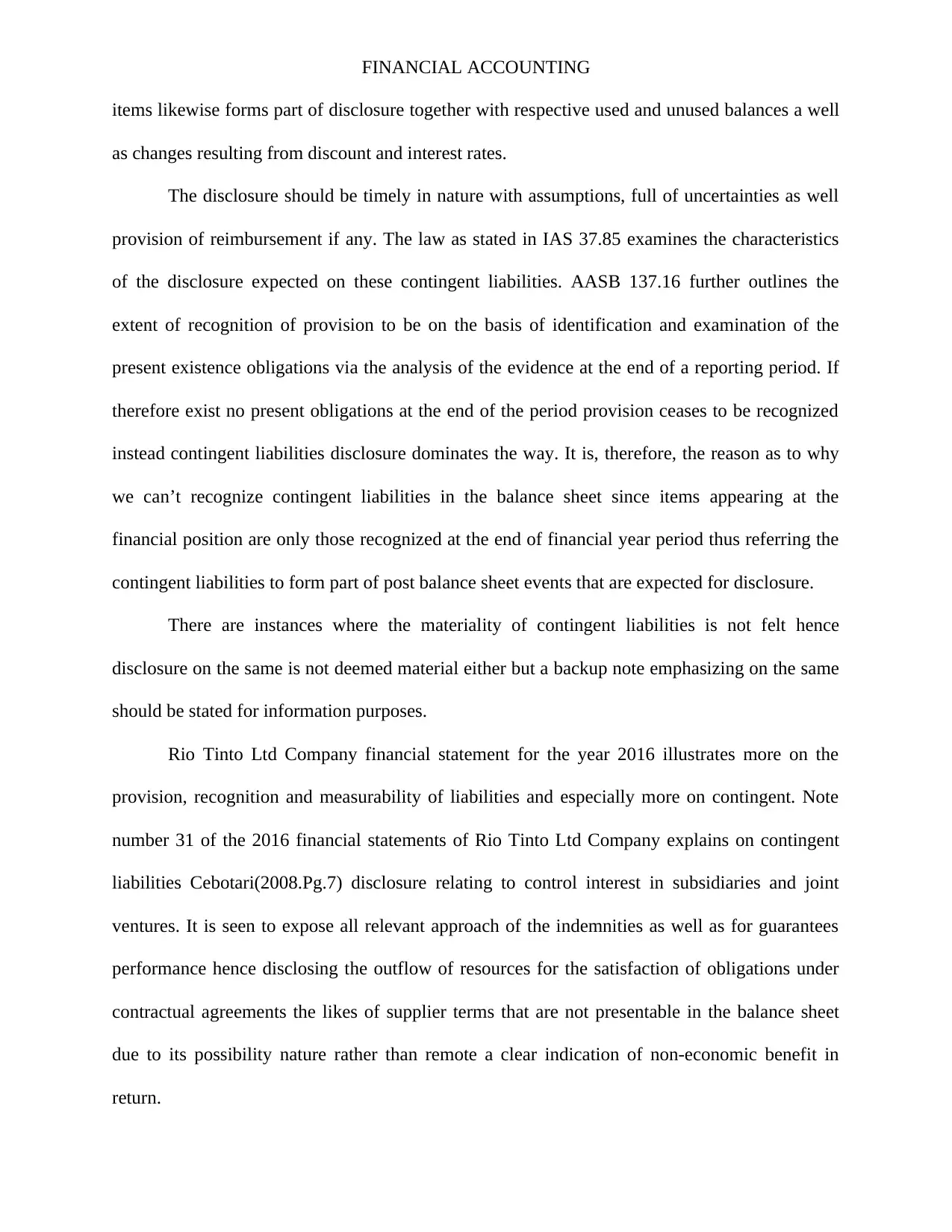
FINANCIAL ACCOUNTING
items likewise forms part of disclosure together with respective used and unused balances a well
as changes resulting from discount and interest rates.
The disclosure should be timely in nature with assumptions, full of uncertainties as well
provision of reimbursement if any. The law as stated in IAS 37.85 examines the characteristics
of the disclosure expected on these contingent liabilities. AASB 137.16 further outlines the
extent of recognition of provision to be on the basis of identification and examination of the
present existence obligations via the analysis of the evidence at the end of a reporting period. If
therefore exist no present obligations at the end of the period provision ceases to be recognized
instead contingent liabilities disclosure dominates the way. It is, therefore, the reason as to why
we can’t recognize contingent liabilities in the balance sheet since items appearing at the
financial position are only those recognized at the end of financial year period thus referring the
contingent liabilities to form part of post balance sheet events that are expected for disclosure.
There are instances where the materiality of contingent liabilities is not felt hence
disclosure on the same is not deemed material either but a backup note emphasizing on the same
should be stated for information purposes.
Rio Tinto Ltd Company financial statement for the year 2016 illustrates more on the
provision, recognition and measurability of liabilities and especially more on contingent. Note
number 31 of the 2016 financial statements of Rio Tinto Ltd Company explains on contingent
liabilities Cebotari(2008.Pg.7) disclosure relating to control interest in subsidiaries and joint
ventures. It is seen to expose all relevant approach of the indemnities as well as for guarantees
performance hence disclosing the outflow of resources for the satisfaction of obligations under
contractual agreements the likes of supplier terms that are not presentable in the balance sheet
due to its possibility nature rather than remote a clear indication of non-economic benefit in
return.
items likewise forms part of disclosure together with respective used and unused balances a well
as changes resulting from discount and interest rates.
The disclosure should be timely in nature with assumptions, full of uncertainties as well
provision of reimbursement if any. The law as stated in IAS 37.85 examines the characteristics
of the disclosure expected on these contingent liabilities. AASB 137.16 further outlines the
extent of recognition of provision to be on the basis of identification and examination of the
present existence obligations via the analysis of the evidence at the end of a reporting period. If
therefore exist no present obligations at the end of the period provision ceases to be recognized
instead contingent liabilities disclosure dominates the way. It is, therefore, the reason as to why
we can’t recognize contingent liabilities in the balance sheet since items appearing at the
financial position are only those recognized at the end of financial year period thus referring the
contingent liabilities to form part of post balance sheet events that are expected for disclosure.
There are instances where the materiality of contingent liabilities is not felt hence
disclosure on the same is not deemed material either but a backup note emphasizing on the same
should be stated for information purposes.
Rio Tinto Ltd Company financial statement for the year 2016 illustrates more on the
provision, recognition and measurability of liabilities and especially more on contingent. Note
number 31 of the 2016 financial statements of Rio Tinto Ltd Company explains on contingent
liabilities Cebotari(2008.Pg.7) disclosure relating to control interest in subsidiaries and joint
ventures. It is seen to expose all relevant approach of the indemnities as well as for guarantees
performance hence disclosing the outflow of resources for the satisfaction of obligations under
contractual agreements the likes of supplier terms that are not presentable in the balance sheet
due to its possibility nature rather than remote a clear indication of non-economic benefit in
return.
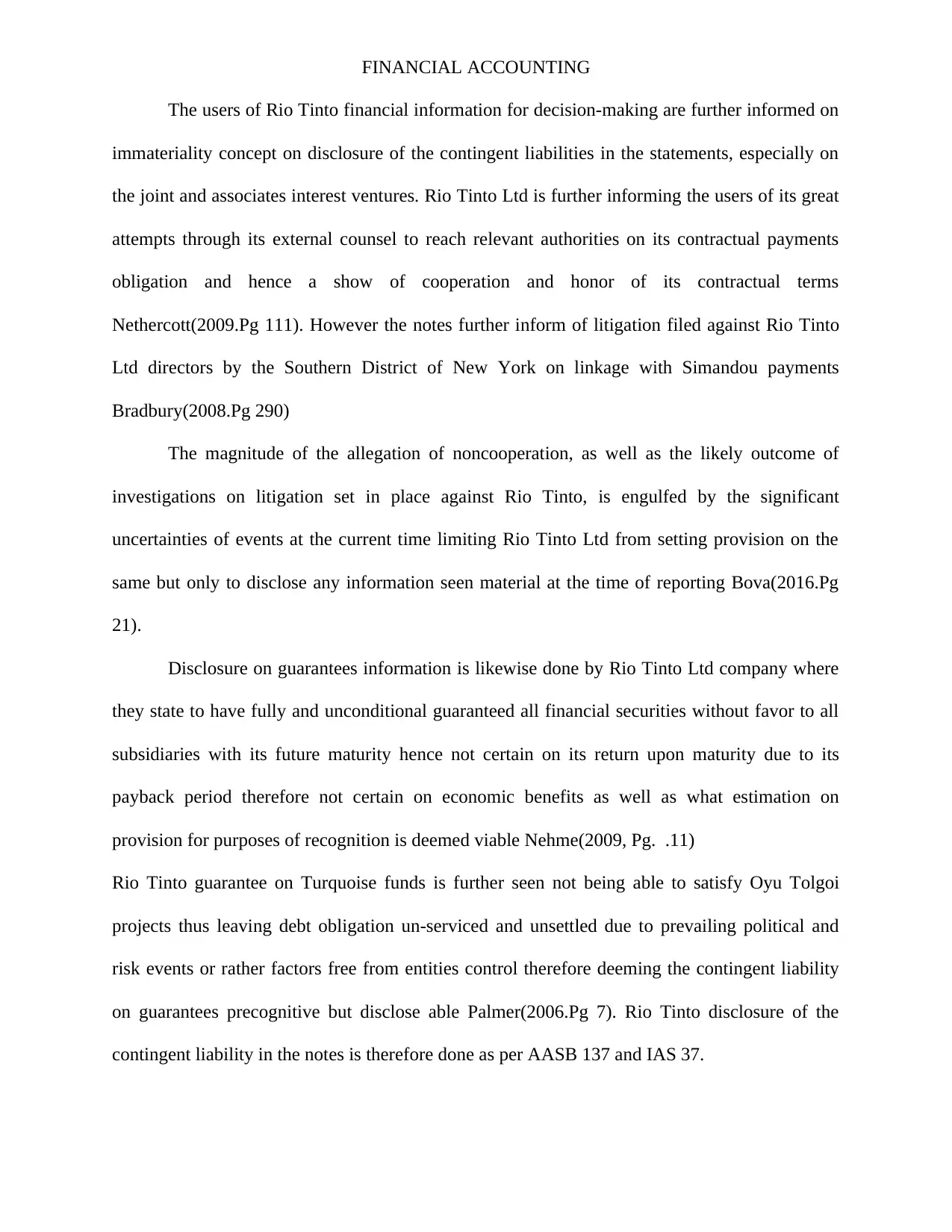
FINANCIAL ACCOUNTING
The users of Rio Tinto financial information for decision-making are further informed on
immateriality concept on disclosure of the contingent liabilities in the statements, especially on
the joint and associates interest ventures. Rio Tinto Ltd is further informing the users of its great
attempts through its external counsel to reach relevant authorities on its contractual payments
obligation and hence a show of cooperation and honor of its contractual terms
Nethercott(2009.Pg 111). However the notes further inform of litigation filed against Rio Tinto
Ltd directors by the Southern District of New York on linkage with Simandou payments
Bradbury(2008.Pg 290)
The magnitude of the allegation of noncooperation, as well as the likely outcome of
investigations on litigation set in place against Rio Tinto, is engulfed by the significant
uncertainties of events at the current time limiting Rio Tinto Ltd from setting provision on the
same but only to disclose any information seen material at the time of reporting Bova(2016.Pg
21).
Disclosure on guarantees information is likewise done by Rio Tinto Ltd company where
they state to have fully and unconditional guaranteed all financial securities without favor to all
subsidiaries with its future maturity hence not certain on its return upon maturity due to its
payback period therefore not certain on economic benefits as well as what estimation on
provision for purposes of recognition is deemed viable Nehme(2009, Pg. .11)
Rio Tinto guarantee on Turquoise funds is further seen not being able to satisfy Oyu Tolgoi
projects thus leaving debt obligation un-serviced and unsettled due to prevailing political and
risk events or rather factors free from entities control therefore deeming the contingent liability
on guarantees precognitive but disclose able Palmer(2006.Pg 7). Rio Tinto disclosure of the
contingent liability in the notes is therefore done as per AASB 137 and IAS 37.
The users of Rio Tinto financial information for decision-making are further informed on
immateriality concept on disclosure of the contingent liabilities in the statements, especially on
the joint and associates interest ventures. Rio Tinto Ltd is further informing the users of its great
attempts through its external counsel to reach relevant authorities on its contractual payments
obligation and hence a show of cooperation and honor of its contractual terms
Nethercott(2009.Pg 111). However the notes further inform of litigation filed against Rio Tinto
Ltd directors by the Southern District of New York on linkage with Simandou payments
Bradbury(2008.Pg 290)
The magnitude of the allegation of noncooperation, as well as the likely outcome of
investigations on litigation set in place against Rio Tinto, is engulfed by the significant
uncertainties of events at the current time limiting Rio Tinto Ltd from setting provision on the
same but only to disclose any information seen material at the time of reporting Bova(2016.Pg
21).
Disclosure on guarantees information is likewise done by Rio Tinto Ltd company where
they state to have fully and unconditional guaranteed all financial securities without favor to all
subsidiaries with its future maturity hence not certain on its return upon maturity due to its
payback period therefore not certain on economic benefits as well as what estimation on
provision for purposes of recognition is deemed viable Nehme(2009, Pg. .11)
Rio Tinto guarantee on Turquoise funds is further seen not being able to satisfy Oyu Tolgoi
projects thus leaving debt obligation un-serviced and unsettled due to prevailing political and
risk events or rather factors free from entities control therefore deeming the contingent liability
on guarantees precognitive but disclose able Palmer(2006.Pg 7). Rio Tinto disclosure of the
contingent liability in the notes is therefore done as per AASB 137 and IAS 37.
⊘ This is a preview!⊘
Do you want full access?
Subscribe today to unlock all pages.

Trusted by 1+ million students worldwide
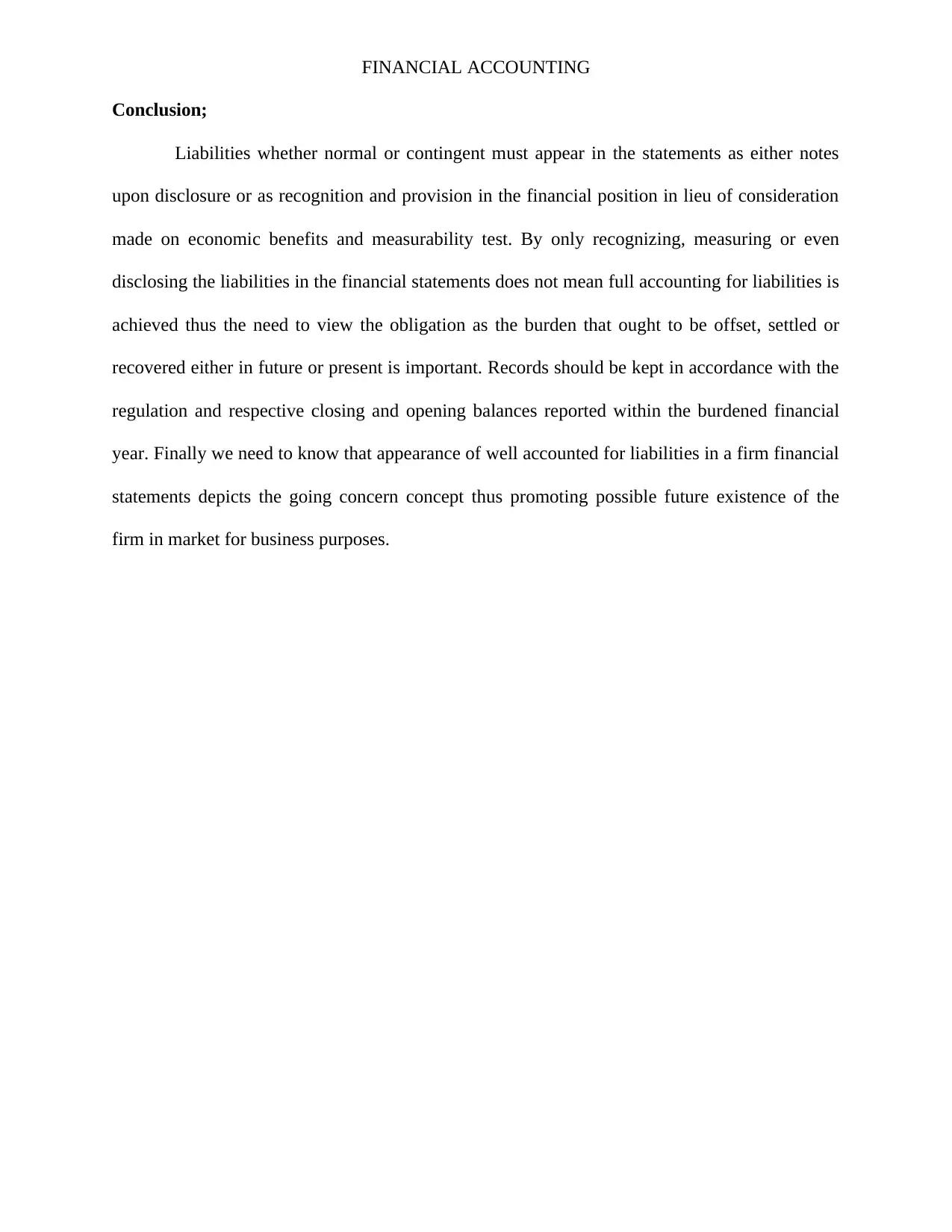
FINANCIAL ACCOUNTING
Conclusion;
Liabilities whether normal or contingent must appear in the statements as either notes
upon disclosure or as recognition and provision in the financial position in lieu of consideration
made on economic benefits and measurability test. By only recognizing, measuring or even
disclosing the liabilities in the financial statements does not mean full accounting for liabilities is
achieved thus the need to view the obligation as the burden that ought to be offset, settled or
recovered either in future or present is important. Records should be kept in accordance with the
regulation and respective closing and opening balances reported within the burdened financial
year. Finally we need to know that appearance of well accounted for liabilities in a firm financial
statements depicts the going concern concept thus promoting possible future existence of the
firm in market for business purposes.
Conclusion;
Liabilities whether normal or contingent must appear in the statements as either notes
upon disclosure or as recognition and provision in the financial position in lieu of consideration
made on economic benefits and measurability test. By only recognizing, measuring or even
disclosing the liabilities in the financial statements does not mean full accounting for liabilities is
achieved thus the need to view the obligation as the burden that ought to be offset, settled or
recovered either in future or present is important. Records should be kept in accordance with the
regulation and respective closing and opening balances reported within the burdened financial
year. Finally we need to know that appearance of well accounted for liabilities in a firm financial
statements depicts the going concern concept thus promoting possible future existence of the
firm in market for business purposes.
Paraphrase This Document
Need a fresh take? Get an instant paraphrase of this document with our AI Paraphraser
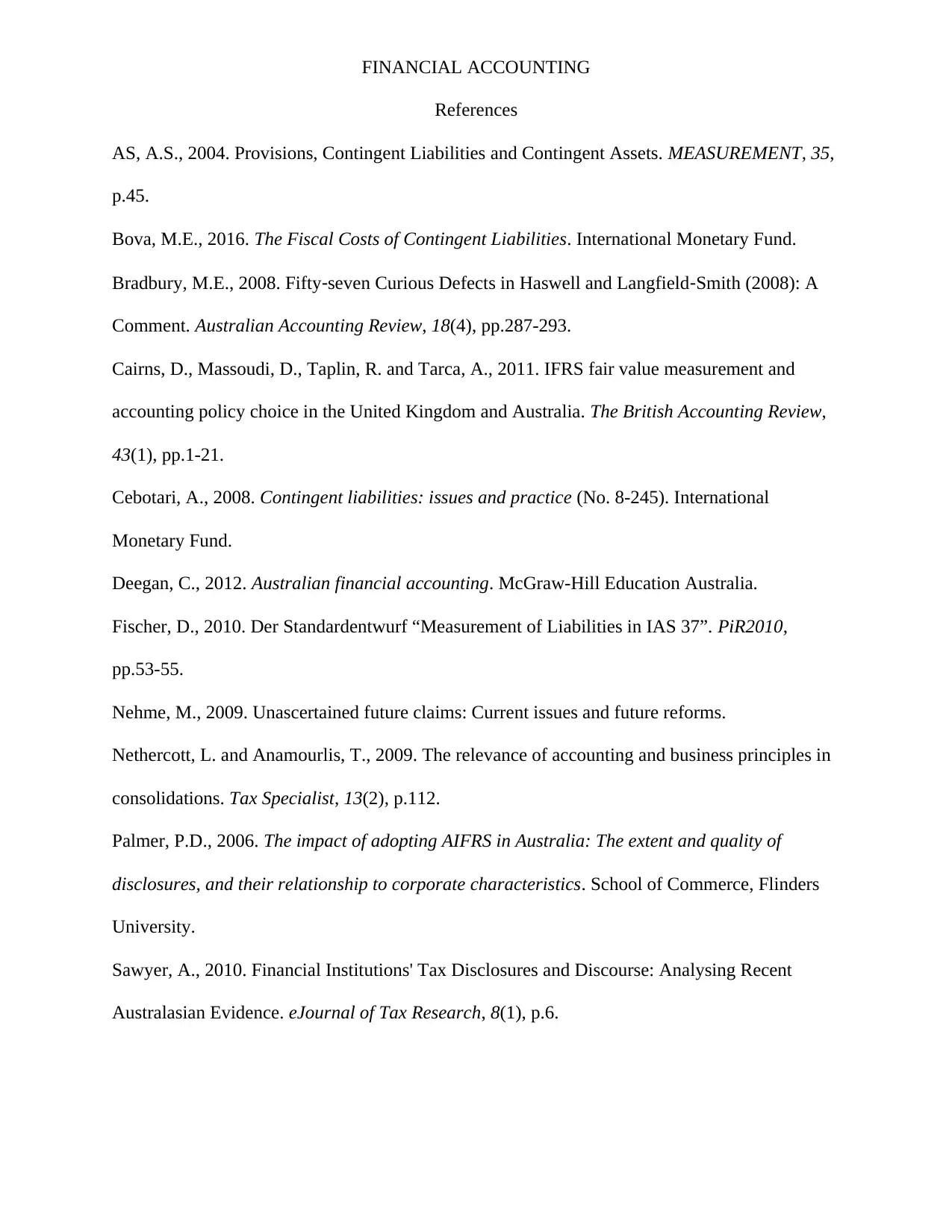
FINANCIAL ACCOUNTING
References
AS, A.S., 2004. Provisions, Contingent Liabilities and Contingent Assets. MEASUREMENT, 35,
p.45.
Bova, M.E., 2016. The Fiscal Costs of Contingent Liabilities. International Monetary Fund.
Bradbury, M.E., 2008. Fifty‐seven Curious Defects in Haswell and Langfield‐Smith (2008): A
Comment. Australian Accounting Review, 18(4), pp.287-293.
Cairns, D., Massoudi, D., Taplin, R. and Tarca, A., 2011. IFRS fair value measurement and
accounting policy choice in the United Kingdom and Australia. The British Accounting Review,
43(1), pp.1-21.
Cebotari, A., 2008. Contingent liabilities: issues and practice (No. 8-245). International
Monetary Fund.
Deegan, C., 2012. Australian financial accounting. McGraw-Hill Education Australia.
Fischer, D., 2010. Der Standardentwurf “Measurement of Liabilities in IAS 37”. PiR2010,
pp.53-55.
Nehme, M., 2009. Unascertained future claims: Current issues and future reforms.
Nethercott, L. and Anamourlis, T., 2009. The relevance of accounting and business principles in
consolidations. Tax Specialist, 13(2), p.112.
Palmer, P.D., 2006. The impact of adopting AIFRS in Australia: The extent and quality of
disclosures, and their relationship to corporate characteristics. School of Commerce, Flinders
University.
Sawyer, A., 2010. Financial Institutions' Tax Disclosures and Discourse: Analysing Recent
Australasian Evidence. eJournal of Tax Research, 8(1), p.6.
References
AS, A.S., 2004. Provisions, Contingent Liabilities and Contingent Assets. MEASUREMENT, 35,
p.45.
Bova, M.E., 2016. The Fiscal Costs of Contingent Liabilities. International Monetary Fund.
Bradbury, M.E., 2008. Fifty‐seven Curious Defects in Haswell and Langfield‐Smith (2008): A
Comment. Australian Accounting Review, 18(4), pp.287-293.
Cairns, D., Massoudi, D., Taplin, R. and Tarca, A., 2011. IFRS fair value measurement and
accounting policy choice in the United Kingdom and Australia. The British Accounting Review,
43(1), pp.1-21.
Cebotari, A., 2008. Contingent liabilities: issues and practice (No. 8-245). International
Monetary Fund.
Deegan, C., 2012. Australian financial accounting. McGraw-Hill Education Australia.
Fischer, D., 2010. Der Standardentwurf “Measurement of Liabilities in IAS 37”. PiR2010,
pp.53-55.
Nehme, M., 2009. Unascertained future claims: Current issues and future reforms.
Nethercott, L. and Anamourlis, T., 2009. The relevance of accounting and business principles in
consolidations. Tax Specialist, 13(2), p.112.
Palmer, P.D., 2006. The impact of adopting AIFRS in Australia: The extent and quality of
disclosures, and their relationship to corporate characteristics. School of Commerce, Flinders
University.
Sawyer, A., 2010. Financial Institutions' Tax Disclosures and Discourse: Analysing Recent
Australasian Evidence. eJournal of Tax Research, 8(1), p.6.
1 out of 8
Related Documents
Your All-in-One AI-Powered Toolkit for Academic Success.
+13062052269
info@desklib.com
Available 24*7 on WhatsApp / Email
![[object Object]](/_next/static/media/star-bottom.7253800d.svg)
Unlock your academic potential
Copyright © 2020–2025 A2Z Services. All Rights Reserved. Developed and managed by ZUCOL.





